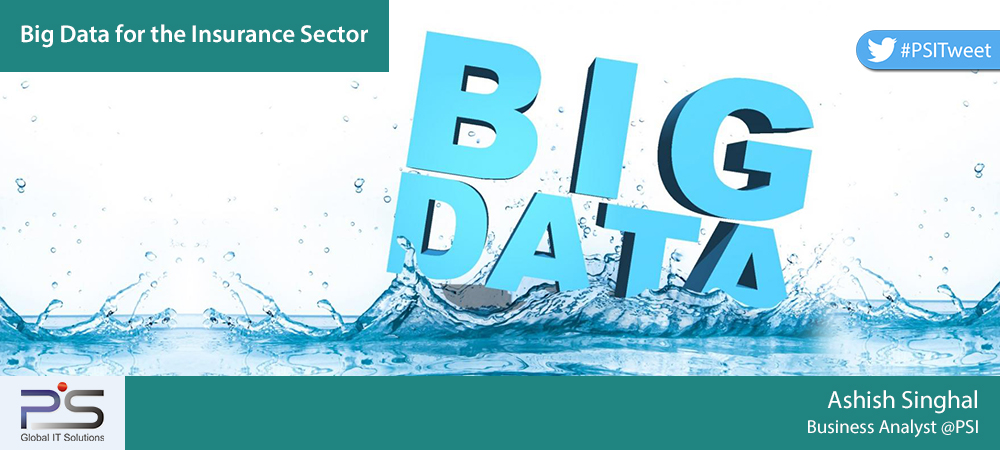
Insurance Sector is expected to double the total premium income in next four years. Indian life insurance market, largest in the world in terms of polices is expected to grow at a pace of 12-15% in the next five years. This generates enormous data about the customers’ behavioural patterns and other aspects of the business. In order to expand and grab a bigger market share the insurers will be required to adopt new methodologies to understand the market dynamics. Big Data analytics can serve the industry requirements of harnessing and harvesting the data available for business decisions.
Big Data will facilitate improved pricing accuracy, cohesive relations with customers and more effective loss prevention. This will help them formulate customised products and value added services for customers in order to reduce losses and manage the risks involved.
The key factors affecting the insurance business are:
- External Data Sources: The new data sources have reduced dependency on internal sources. The social media, smart phones and other digital devices all generate insights in behavioural patterns. This data along with other open data by government and research agencies help the insurers understand the different risks. For example, the probability of people residing in a particular location will die in road accidents or may face losses due to natural calamities can be calculated.
- Better Risk Calculating Tools: The insurers primarily work on different models to assess the risks. They may include data from advance medical technologies, lifestyle patterns, income levels etc. to analyse the possibilities.
- Real-time Data Monitoring: By allowing insurers to monitor consumer behaviour, the consumers are also able to understand themselves in a better manner. For example, the drivers have become more cautious while driving vehicles on highways after realizing their risky conduct on roads.
The insurers can use Big Data to create value in different ways depending on their business strategies. Few of the examples could be:
- Improvements in the DWH environments: Relational database, ETL solution, OLAP engine, client analysis tools and other apps for collecting and delivering data to users.
- Educating customers through social media: The customers are informed about the new products and services by promoting them on social media. They are a cost effective medium and can be tracked for result analysis.
- Integrating communication channels: The combining of different mediums will help in presenting a complete 360° view of the customer requirements and service levels.
- Improved pricing models: The real time data along with other external sources provides information about the increased probabilities of the risks.
- Fraud detection: Number of fraud cases has increased in recent times. People create false evidences to collect insurance money from the companies. The insurers need to track the social media, police reports and news agencies to know about the actual accidents and other misfortunes.
- Conducting customer info and satisfaction surveys: The Big Data will enable the insurers to have in depth surveys of the entire customer base and prospective customers in cost effective manner to have a clear picture
Once the insurers plan to merge the Big Data technologies into businesses, they will have to compress the existing processes according to the data’s 5V. The analytics driven culture of Big Data will create a competitive advantage and impact their businesses.
The tools for Big Data Analytics like R, MATLAB, SAS, SPSS along with the other statistical techniques will be beneficial for the insurance sector. The Actuarial science is the backbone of the Insurance sector, wherein the mathematical and statistical tools are used to assess the risks involved when developing an insurance plan. The different aspects of environment are categorised into groups like cultural, social, personal and psychological factors, which can be further sub-classified to study and infer from the actual situational data rather than estimating the statistics. This will not only help the insurers, but also consumers in the long run.
Ashish Singhal is a Business Analyst @ PSI
Image Courtesy: www.datamentors.comInsurance Sector is expected to double the total premium income in next four years. Indian life insurance market, largest in the world in terms of polices is expected to grow at a pace of 12-15% in the next five years. This generates enormous data about the customers’ behavioural patterns and other aspects of the business. In order to expand and grab a bigger market share the insurers will be required to adopt new methodologies to understand the market dynamics. Big Data analytics can serve the industry requirements of harnessing and harvesting the data available for business decisions.
Big Data will facilitate improved pricing accuracy, cohesive relations with customers and more effective loss prevention. This will help them formulate customised products and value added services for customers in order to reduce losses and manage the risks involved.
The key factors affecting the insurance business are:
- External Data Sources: The new data sources have reduced dependency on internal sources. The social media, smart phones and other digital devices all generate insights in behavioural patterns. This data along with other open data by government and research agencies help the insurers understand the different risks. For example, the probability of people residing in a particular location will die in road accidents or may face losses due to natural calamities can be calculated.
- Better Risk Calculating Tools: The insurers primarily work on different models to assess the risks. They may include data from advance medical technologies, lifestyle patterns, income levels etc. to analyse the possibilities.
- Real-time Data Monitoring: By allowing insurers to monitor consumer behaviour, the consumers are also able to understand themselves in a better manner. For example, the drivers have become more cautious while driving vehicles on highways after realizing their risky conduct on roads.
The insurers can use Big Data to create value in different ways depending on their business strategies. Few of the examples could be:
- Improvements in the DWH environments: Relational database, ETL solution, OLAP engine, client analysis tools and other apps for collecting and delivering data to users.
- Educating customers through social media: The customers are informed about the new products and services by promoting them on social media. They are a cost effective medium and can be tracked for result analysis.
- Integrating communication channels: The combining of different mediums will help in presenting a complete 360° view of the customer requirements and service levels.
- Improved pricing models: The real time data along with other external sources provides information about the increased probabilities of the risks.
- Fraud detection: Number of fraud cases has increased in recent times. People create false evidences to collect insurance money from the companies. The insurers need to track the social media, police reports and news agencies to know about the actual accidents and other misfortunes.
- Conducting customer info and satisfaction surveys: The Big Data will enable the insurers to have in depth surveys of the entire customer base and prospective customers in cost effective manner to have a clear picture
Once the insurers plan to merge the Big Data technologies into businesses, they will have to compress the existing processes according to the data’s 5V. The analytics driven culture of Big Data will create a competitive advantage and impact their businesses.
The tools for Big Data Analytics like R, MATLAB, SAS, SPSS along with the other statistical techniques will be beneficial for the insurance sector. The Actuarial science is the backbone of the Insurance sector, wherein the mathematical and statistical tools are used to assess the risks involved when developing an insurance plan. The different aspects of environment are categorised into groups like cultural, social, personal and psychological factors, which can be further sub-classified to study and infer from the actual situational data rather than estimating the statistics. This will not only help the insurers, but also consumers in the long run.
Ashish Singhal is a Business Analyst @ PSI
Image Courtesy: www.datamentors.com[:]








